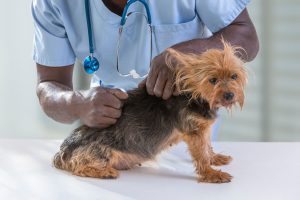A prospective study evaluating the adhesive tape impression for the diagnosis of dermatophytosis in dogs and cats
A prospective study evaluating the adhesive tape impression for the diagnosis of dermatophytosis in dogs and cats

Requires membership/payment
This article can be accessed via RCVS Knowledge Library Membership (click here).
In our edition of: Oct 2024
In our categories of: small animals
our summary:
Ludwig, C.B. et al. (2024) A prospective study evaluating the adhesive tape impression for the diagnosis of dermatophytosis in dogs and cats. Veterinary Dermatology.
The aim of this prospective study was to evaluate the diagnostic ability of the adhesive tape impression (ATI) to detect dermatophytosis compared to trichogram (hair pluck), Wood’s Lamp (WL) examination and fungal culture, and to evaluate the ease of use of the ATI compared to the trichogram.
Cases presenting at a referral veterinary hospital in Australia, between July 2022-June 2023, with clinical lesions, a previous history of dermatophytosis and a confirmed diagnosis on at least two diagnostic techniques were eligible for inclusion. After initial screening final inclusion in the study required confirmation of diagnosis on at least two diagnostic tests (fungal culture, point- of- care techniques, histopathological results). Cases were excluded if topical or oral anti- fungal treatments were administered before sampling.
Suspect lesions were initially examined under the WL. Then in each case, half of the representative lesion site was sampled with a trichogram and an ATI, and the other half sampled for fungal culture. Skin biopsies were taken if there were any indications for further clarification.
Twenty cases were included in the final analysis – 15 cats and five dogs, lesions consisted of partial-to-complete alopecia with varying degrees of crusting and erythema. Nineteen cases had a positive fungal culture of which 16 were cases of Microsporum canis (14 cats, 2 dogs). There was one case each of Nannizzia gypsea, Trichophyton mentagrophytes and T. rubrum, all in dogs.
ATI was positive in 100% of cases, with trichogram, fungal culture and WL positive in 90%, 95% and 65% of patients respectively. There was a significant difference between ATI and WL. Fungal elements were detected in >20 high-powered-fields more frequently with ATI (18/20) than trichogram (11/20).
In comparison to trichogram, ATI was subjectively considered to be faster and identification of fungal elements easier. Fungal elements were located with neutrophil clusters and sheets of keratinocytes in addition to abnormal hair fragments more frequently on ATI.
Limitations of the study include the small number of included cases and a lack of a negative cohort. The case selection method may have biased results towards cases that were cytologically or WL positive.
Moriello, K.A. et al (2017) Diagnosis and treatment of dermatophytosis in dogs and cats. Veterinary Dermatology, 28 (3), pp. 266-e68. https://doi.org/10.1111/vde.12440
Frymus, T. (2013) Dermatophytosis in Cats: ABCD guidelines on prevention and management. Journal of Feline Medicine and Surgery, 15 (7), pp. 598-604. https://doi.org/10.1177/1098612X13489222
Moriello, K. (2019) Dermatophytosis in cats and dogs: a practical guide to diagnosis and treatment. In Practice, 41 (4), pp. 138-147. https://doi.org/10.1136/inp.l1539
Claiming CPD for reading inFOCUS articles
Reading and reflecting on articles can count towards your CPD, and we have a template to help you with the process.
Image copyright attribute: chassenet / 123RF Stock Photo






Leave a Reply
Want to join the discussion?Feel free to contribute!